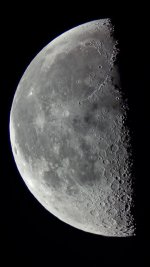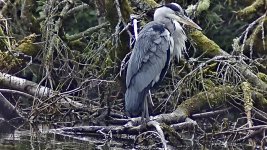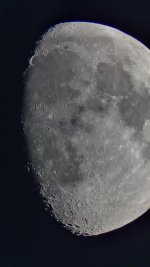-
Welcome to BirdForum, the internet's largest birding community with thousands of members from all over the world. The forums are dedicated to wild birds, birding, binoculars and equipment and all that goes with it.
Please register for an account to take part in the discussions in the forum, post your pictures in the gallery and more.
You are using an out of date browser. It may not display this or other websites correctly.
You should upgrade or use an alternative browser.
You should upgrade or use an alternative browser.
Product Review Part II: Svbony SA405 85mm ED Spotting Scope: Eyepieces & Imaging Capabilities. (4 Viewers)
- Thread starter Dipperdapper
- Start date
More options
Who Replied?Has anyone compared the ED/APO versions of SVBony spotting scopes against high-end spotting scopes (Swaro, Kowa, Zeiss)? I am curious how much image quality gain you get by paying 5-10x the price. From my experience you can only get minor increase in CA control since, I can hardly see any CA in my scopes. I can also change my eyepieces to get same AFOV or better as the expensive scopes. That would only leave resolution (across enter FOV), brightness and contrast improvements possible. I also find changing my eyepieces can make a difference here. In most cases I am limited by atmospheric condition and not by the resolution of my scope. I am curious how they compare measured on resolution charts under bright and dark conditions.
Last edited:
Dipperdapper
Well-known member
henry link
Well-known member
I don't know anybody who has done exactly that yet. The high opinions we are getting about the SVbony scopes are very intriguing, but I would like to see exactly the same tests applied to them that we've seen applied to high end scopes here, like photos of high magnification star tests and resolution measurements using a standard chart like the USAF 1951. Neil's test is the closest we've had, but the photos he's posted are of limited usefulness because we don't know if, on our computer screens, their image scale subtends the equivalent of 20x or 100x at the eyepiece, or how they have been affected by the limitations of the camera sensor or how uploading has degraded them.Has anyone compared the ED/APO versions of SVBony spotting scopes against high-end spotting scopes (Swaro, Kowa, Zeiss)? I am curious how much image quality gain you get by paying 5-10x the price. From my experience you can only get minor increase in CA control since, I can hardly see any CA in my scopes. I can also change my eyepieces to get same AFOV or better as the expensive scopes. That would only leave resolution (across enter FOV), brightness and contrast improvements possible. I also find changing my eyepieces can make a difference here. In most cases I am limited by atmospheric condition and not by the resolution of my scope. I am curious how they compare measured on resolution charts under bright and dark conditions.
I know from personal experience that the $1600 Chinese made Nikon Monarch 82ED is in the same class optically as the most expensive scopes out there. Is it possible that some sub $1000 scopes could also be that good? Let's see the hard evidence.
I didn’t realize that the Nikon Monarch 82ED spotting scope was made in China. It is an interesting spotting scope, since it hits above it’s price point in optical performance. It is unusual for a scope to include a field flattener in their lens elements at this price point. This gives their scope even sharpness across the field of view. It seems that the Japanese and German/Austrian manufacturers cannot compete with the Chinese manufacturers at this price range and bellow any longer. I can soon see that Chinese optics manufacturing will compete and surpass the current high-end manufacturers in the near future (at least they will in price).I don't know anybody who has done exactly that yet. The high opinions we are getting about the SVbony scopes are very intriguing, but I would like to see exactly the same tests applied to them that we've seen applied to high end scopes here, like photos of high magnification star tests and resolution measurements using a standard chart like the USAF 1951. Neil's test is the closest we've had, but the photos he's posted are of limited usefulness because we don't know if, on our computer screens, their image scale subtends the equivalent of 20x or 100x at the eyepiece, or how they have been affected by the limitations of the camera sensor or how uploading has degraded them.
I know from personal experience that the $1600 Chinese made Nikon Monarch 82ED is in the same class optically as the most expensive scopes out there. Is it possible that some sub $1000 scopes could also be that good? Let's see the hard evidence.
I had a real shock from Chinese optics when I purchased a 23mm aspheric eyepiece (the all glass one) for $13 a few years back. It was performing better than many of my eyepieces costing over $100 dollars. I have high-end eyepieces from Televue that outperform this eyepiece, but they are much heavier and cost 45x more. I still find this eyepiece pleasing to use and still use it in my telescopes and spotting scopes.
Last edited:
The SVbony scope poses interesting questions.
Over the last few years the reports of the quality of Swarovski, Zeiss, Kowa and Leica spotting scopes has been very mixed, with the pass rate pretty low for certain examples.
Although the experts here seek out cherry examples, it seems they might test ten before they find the one they want.
This sets the bar pretty low for a well set up well specified SVbony scope.
So the average top four quality may be quite easy to achieve optically.
Then Nikon seems to equal these top four.
Whether the long term reliability in hard use can compare, I doubt it.
What would have helped the top makes is a much higher pass rate quality, but they decided to rely on their name and keep the bar low.
It wouldn't surprise me if a good Svbony is better than a an average or poor top make.
As always testing is needed.
Star tests and resolution tests.
For me the tests were simple. A simple star test and 150x to 200x on Jupiter, Mars or Saturn.
This immediately shows which scopes are good and which aren't.
For me 60x on a 80mm scope is not much of a test at all.
And I don't test in rubbish Seeing.
Regards,
B.
Over the last few years the reports of the quality of Swarovski, Zeiss, Kowa and Leica spotting scopes has been very mixed, with the pass rate pretty low for certain examples.
Although the experts here seek out cherry examples, it seems they might test ten before they find the one they want.
This sets the bar pretty low for a well set up well specified SVbony scope.
So the average top four quality may be quite easy to achieve optically.
Then Nikon seems to equal these top four.
Whether the long term reliability in hard use can compare, I doubt it.
What would have helped the top makes is a much higher pass rate quality, but they decided to rely on their name and keep the bar low.
It wouldn't surprise me if a good Svbony is better than a an average or poor top make.
As always testing is needed.
Star tests and resolution tests.
For me the tests were simple. A simple star test and 150x to 200x on Jupiter, Mars or Saturn.
This immediately shows which scopes are good and which aren't.
For me 60x on a 80mm scope is not much of a test at all.
And I don't test in rubbish Seeing.
Regards,
B.
Dipperdapper
Well-known member
I don't know if I can be much help Henry, but I had one sample of the SV406P that I can provide some observations on. The 16-48x65mm ED version.The high opinions we are getting about the SVbony scopes are very intriguing, but I would like to see exactly the same tests applied to them that we've seen applied to high end scopes here, like photos of high magnification star tests and resolution measurements using a standard chart like the USAF 1951.
It seemed OK at 48x on simple targets indoors, but didn't exactly snap into focus even with the dual focus mechanism. I could get decent focus with the fine knob, but not as quickly or as easily as some old Nikons with helical focus for example.
I did a star test indoors at close range and didn't see anything really bad with the patterns. It actually looked good for shape and concentricity, but I would not say that I am super skilled at evaluating star tests. It was definitely a bit green on one side of focus, and purple the other side of focus.
Resolution at close range seemed pretty good compared to two EDIII that I had, but based on memory only. I didn't compare side by side. I did have an 82mm for reference though, and have used the same basic targets for awhile.
Anyway at that point I thought that the SVBONY was actually OK, especially for the price. So I took it outdoors and the first thing that I noticed was the lack of color fringing at 48x that I have seen with other low cost scopes with similar aperture and magnification (but non-ED). Another good sign I thought.
Where it got really interesting was the fact that I could not get the sharp focus at distance that I expected on natural objects. It was difficult to distinguish between different shades of brown, for example. I don't know if this is even possible, but it seemed like the lack of detail in the image wasn't due to the focus per se but simply the lack of contrast. And I have looked at that scenery countless times under various conditions with numerous scopes.
Unfortunately I didn't have a 60-65mm reference scope, but did have my 82mm which came to focus just fine with great detail in the image.
Jason
henry link
Well-known member
Hi Jason,
Was your 65mm SVBony under or over corrected for spherical aberration at close distances? I ask because most spotting scopes are undercorrected close up and improve at longer distances. A scope that looks a little overcorrected up close would probably get worse at long distances. That might explain your impressions in paragraph 6.
Henry
Was your 65mm SVBony under or over corrected for spherical aberration at close distances? I ask because most spotting scopes are undercorrected close up and improve at longer distances. A scope that looks a little overcorrected up close would probably get worse at long distances. That might explain your impressions in paragraph 6.
Henry
Hi Henry,
I checked my notes on the 65mm SVBONY but unfortunately I didn't have any details on under or over correction. Sorry about that. It was an extremely quick look to check for obvious flaws. However, I have tested quite a few scopes and I don't recall ever seeing one over corrected at close range.
Thanks for the information on distance too. I have seen under corrected scopes look closer to perfect with real stars or artificial stars at several hundred yards. Now I know why.
Jason
I checked my notes on the 65mm SVBONY but unfortunately I didn't have any details on under or over correction. Sorry about that. It was an extremely quick look to check for obvious flaws. However, I have tested quite a few scopes and I don't recall ever seeing one over corrected at close range.
Thanks for the information on distance too. I have seen under corrected scopes look closer to perfect with real stars or artificial stars at several hundred yards. Now I know why.
Jason
My dual focuser works very well on my SVBony SV46P 20-60x 80mm spotting scope. I like it better than my helical focuser on my SVBony SA401 20-60x 85mm spotting scope. The SV46P actually seemed to be slightly under corrected at close range and improves at further distance. The main reason I like the dual focuser, is that the dual focusers doesn't shake the spotting scope so much when I adjust fine focus at 60x. The helical focuser is just fine and would actually be quicker to get to focus, if I didn't have to bother about spotting scope shaking at high power. For moving targets and at 20x, the helical focus is quicker to focus.
You may have a quality control issue with your SV406p 65mm spotting scope. I have heard other say that the SV406P 20-60x 80mm spotting scope is actually sharper than the SV46P at 60x long range. My SV46P is sharp and shows good contrast. It is not as good as the SA401, but I like the look of the colours in the SV46P a bit better. My main problem with long range testing, is that the atmospheric conditions are usually not good enough to get sharp focus. This is true even for my 200mm" telescope. I need to use lucky imaging to punch through the atmospheric distortions. I am really interested to hear a comparison of these SVBony scopes against the alpha scopes with real objective metrics.
You may have a quality control issue with your SV406p 65mm spotting scope. I have heard other say that the SV406P 20-60x 80mm spotting scope is actually sharper than the SV46P at 60x long range. My SV46P is sharp and shows good contrast. It is not as good as the SA401, but I like the look of the colours in the SV46P a bit better. My main problem with long range testing, is that the atmospheric conditions are usually not good enough to get sharp focus. This is true even for my 200mm" telescope. I need to use lucky imaging to punch through the atmospheric distortions. I am really interested to hear a comparison of these SVBony scopes against the alpha scopes with real objective metrics.
That's good to know about the focuser on that 80mm. The coarse focuser on my 65mm was a bit stiff, but the fine focus was OK.My dual focuser works very well on my SVBony SV46P 20-60x 80mm spotting scope. I like it better than my helical focuser on my SVBony SA401 20-60x 85mm spotting scope. The SV46P actually seemed to be slightly under corrected at close range and improves at further distance. The main reason I like the dual focuser, is that the dual focusers doesn't shake the spotting scope so much when I adjust fine focus at 60x. The helical focuser is just fine and would actually be quicker to get to focus, if I didn't have to bother about spotting scope shaking at high power. For moving targets and at 20x, the helical focus is quicker to focus.
I really don't have a preference for helical or dual focus belt drive mechanisms, other than the helical seems easier to use with gloves on. I've never noticed helical focusers creating excess vibration, but have only owned four scope with that mechanism. Each have snapped into focus, and one in particular is super easy to get into focus with a small nudge of the focus. It seems to have superb optics from what I have seen with star tests and resolution tests. But I also have a lot of experience with that scope so that is probably a factor.
I have assumed that excess vibration from focusing with any scope is usually due to scopes that have a band of best focus and not a distinct point of best focus, which creates the user to hunt. In that case, I could see the dual focus mechanism having less vibration. I could be completely off base on that, but have owned and used several mediocre scopes which made me hunt for best focus.
I should clarify and state that the 65mm SVBONY was OK in my mind for a ~$200 scope. If I didn't already own a scope(s) I might have kept it. Overall it seemed better than some of the low budget scopes that I have owned and used. For example, I had also tried a 65mm Athlon that seemed worse and was double the price.You may have a quality control issue with your SV406p 65mm spotting scope. I have heard other say that the SV406P 20-60x 80mm spotting scope is actually sharper than the SV46P at 60x long range. My SV46P is sharp and shows good contrast. It is not as good as the SA401, but I like the look of the colours in the SV46P a bit better. My main problem with long range testing, is that the atmospheric conditions are usually not good enough to get sharp focus. This is true even for my 200mm" telescope. I need to use lucky imaging to punch through the atmospheric distortions. I am really interested to hear a comparison of these SVBony scopes against the alpha scopes with real objective metrics.
However, I also think that it was unrealistic for me to think that it would compare well to my more expensive scopes. I was thinking that I would use the SVBONY as a loaner scope or something to keep in the car but from what I have seen I think I would just get an old Nikon instead.
Dipperdapper
Well-known member
This image was captured in the wee small hours of August 8 showing the last quarter Moon using the SA405 spotting scope and SC001 imaging camera:

At 02:45 local time, Jupiter was also located just a few degrees southeast of the Moon and I took the opportunity to observe the planet with the SA 405 scope and 4mm Plossl eyepiece delivering 121x. I can report an excellent result. The image of the planet was fine and sharp, showing two prominent bands (SEB & NEB) and a couple of more subtle bands at higher and lower latitudes. Just a trace of CA seen on the planet's limb. The four Galilean satellites were also resolved as stellar-like point sources- two on either side of the planet. Overall, very pleased with its high-power capabilities, especially with the planet's sub-optimal altitude in my local sky at this time.

At 02:45 local time, Jupiter was also located just a few degrees southeast of the Moon and I took the opportunity to observe the planet with the SA 405 scope and 4mm Plossl eyepiece delivering 121x. I can report an excellent result. The image of the planet was fine and sharp, showing two prominent bands (SEB & NEB) and a couple of more subtle bands at higher and lower latitudes. Just a trace of CA seen on the planet's limb. The four Galilean satellites were also resolved as stellar-like point sources- two on either side of the planet. Overall, very pleased with its high-power capabilities, especially with the planet's sub-optimal altitude in my local sky at this time.
Great second part to your earlier review on your website!This image was captured in the wee small hours of August 8 showing the last quarter Moon using the SA405 spotting scope and SC001 imaging camera:
View attachment 1525048
At 02:45 local time, Jupiter was also located just a few degrees southeast of the Moon and I took the opportunity to observe the planet with the SA 405 scope and 4mm Plossl eyepiece delivering 121x. I can report an excellent result. The image of the planet was fine and sharp, showing two prominent bands (SEB & NEB) and a couple of more subtle bands at higher and lower latitudes. Just a trace of CA seen on the planet's limb. The four Galilean satellites were also resolved as stellar-like point sources- two on either side of the planet. Overall, very pleased with its high-power capabilities, especially with the planet's sub-optimal altitude in my local sky at this time.
I have the SC01 WiFi camera and the SVBony SA401 apo spotting scope and I find the camera adds a little bit of chromatic aberration that I don’t see through the zoom eyepiece. Also, some eyepieces add some lateral chromatic aberration I also don’t see in the zoom eyepiece. Also, depending on the latitude of the object in the sky, I can often see chromatic aberration from the atmosphere on bright astro targets. I didn’t try the SC01 camera on astro targets, but I have noticed this on high contrast daylight targets.
Does the 25mm XCel eyepiece show sharp focus across the entire field of view?
Last edited:
Dipperdapper
Well-known member
Thanks Astroguy,
Using the 25mm Celestron X-Cel-LX eyepiece featured in the review, the image remains nice and crisp across most of the field of view with a touch of peripheral softness creeping in at the outer 10-15 per cent of the field. Most of this can focused out, indicating that the primary aberration is field curvature.
Regards,
Neil
Using the 25mm Celestron X-Cel-LX eyepiece featured in the review, the image remains nice and crisp across most of the field of view with a touch of peripheral softness creeping in at the outer 10-15 per cent of the field. Most of this can focused out, indicating that the primary aberration is field curvature.
Regards,
Neil
Dipperdapper
Well-known member
Hello Again,
I spotted an immature Cormorant up at our local pond and set up the SA405 spotting scope and SC001 imaging camera to take some images.
Conditions were still, largely overcast with some brighter spells. Distance about 100 yards. All images are unprocessed i.e. straight from the imaging camera:



Very pleased with its performance!
I spotted an immature Cormorant up at our local pond and set up the SA405 spotting scope and SC001 imaging camera to take some images.
Conditions were still, largely overcast with some brighter spells. Distance about 100 yards. All images are unprocessed i.e. straight from the imaging camera:



Very pleased with its performance!
Users who are viewing this thread
Total: 5 (members: 0, guests: 5)







